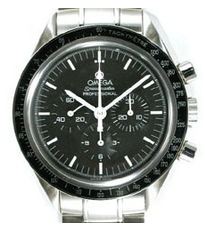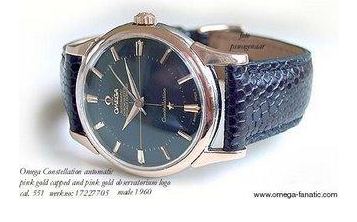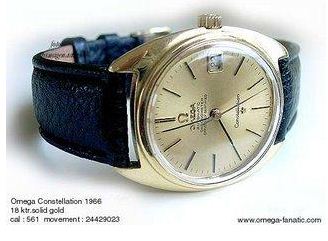Omega Moonwatch
Source: Wikipedia
Launched in 1957 by Omega, the Moonwatch is a type of Omega Speedmaster watch which was selected by theNASA for the Project Apollo. As such, they became the first watches worn on the moon, gaining the nickname.
 The Speedmaster passed NASA’s numerous torture tests, which included exposure to extreme temperatures, vacuum, intense humidity, corrosion, shock, acceleration, pressure, vibration and noise [1], whereas the Rolex,Breitling, Bulova, Longines, TAG Heuer etc. all failed.
The Speedmaster passed NASA’s numerous torture tests, which included exposure to extreme temperatures, vacuum, intense humidity, corrosion, shock, acceleration, pressure, vibration and noise [1], whereas the Rolex,Breitling, Bulova, Longines, TAG Heuer etc. all failed.
The Speedmaster is the only watch to be worn on the moon (except for the Waltham worn by Dave Scott after the crystal had popped off his Speedmaster), and the only watch flight-qualified for extra-vehicular use by NASA. It is the watch chosen for use in outer space by the Russian space agency NPO Energija.
The complete story behind the Omega Moonwatch The “Space Race” immerged out of the “Cold War” between the United States and the Soviet Union and was in full swing in the 1960s. The Space Race began on October 4, 1957 when the Soviet Union launched the first artificial satellite, Sputnik. President Eisenhower formed the “National Aeronautics And Space Administration” (NASA) in July of 1958 with the specific goal of manned space flight, and the eventual landing of a manned spacecraft on the moon.
Three sequential Space Programs were established, Mercury, Gemini, and Apollo, and each program was designed with specific goals to bring the United States closer to a manned Moon Mission. The Mercury programs launched one astronaut per flight; the Gemini spacecraft carried two astronauts on each flight, and three astronauts manned the Apollo missions.
The era of the Space Race was a very exciting time in American history and the success of the “Apollo Program” is without a doubt one of the most amazing accomplishments in human history. The Apollo Program began in 1967, and by the end of 1972, twenty-four men had traveled the quarter of a million miles from the Earth to the Moon. Three of these men made the trip twice, and twelve of them actually walked on the Moon.
The Gemini Program flights started in early 1965 and were to include the first extravehicular space-walks. The first EVA space-walk was scheduled to take place on Gemini 4 in June of 1965. Each of the three Space Programs required specialized equipment to complete their missions, but when the step-by-step procedures of the Gemini space-walks were first mapped out, NASA realized that they had overlooked the requirements for specialized personal timekeeping devices for the Astronauts. NASA did not have an approved wristwatch for space travel. (Quartz wristwatches did not come out until after 1970 and good, reliable mechanical waterproof and shockproof wristwatches were difficult to find in the 1960s).
The normal procedure of soliciting bids for the design, manufacture and testing of special “Space Proof” wristwatches was a time consuming process, and NASA just didn’t have the time. So, NASA sent two Systems Engineers into downtown Houston “incognito” to purchase several reputable “off-the-shelf” chronographs to be tested for possible use in space. Most of the Astronauts were already “Jet-Jockeys,” and as such, they were familiar with specialized hardware. So, the systems engineers first interviewed the astronauts to find out what they were currently using as their personal flight wristwatches. Although it was unlikely, NASA engineers were hoping that some of the current “off-the-shelf” high-end brands of wristwatches would be able to withstand the testing requirements of the extreme conditions of space.
Five different brands of Chronographs were purchased and returned to NASA for testing. After the first round of tests, two of the five brands were disqualified. And, after the  second round of tests, only one wristwatch, the “Omega Speedmaster Professional,” survived. NASA ordered several more watches of each of the brands tested, including twelve Omega Speedmasters. NASA paid the retail price of $82.50 for each Speedmaster and arranged for a final series of tests to finally determine the best wristwatch to use in space. The tests were completed on March 1, 1965. At the completion of the tests, three of the chronographs from different manufactures were still running, but only the Speedmaster had passed without any of the serious discrepancies encountered with the others. The Omega Speedmaster was adopted by NASA as the “Officially Certified Wristwatch For All Manned Space Missions.” The Omega Watch Company was completely unaware of these activities and they did not know that one of their watches had been tested and selected by NASA as the official wristwatch of the American Space Program!
second round of tests, only one wristwatch, the “Omega Speedmaster Professional,” survived. NASA ordered several more watches of each of the brands tested, including twelve Omega Speedmasters. NASA paid the retail price of $82.50 for each Speedmaster and arranged for a final series of tests to finally determine the best wristwatch to use in space. The tests were completed on March 1, 1965. At the completion of the tests, three of the chronographs from different manufactures were still running, but only the Speedmaster had passed without any of the serious discrepancies encountered with the others. The Omega Speedmaster was adopted by NASA as the “Officially Certified Wristwatch For All Manned Space Missions.” The Omega Watch Company was completely unaware of these activities and they did not know that one of their watches had been tested and selected by NASA as the official wristwatch of the American Space Program!
Omega Speedmasters were purchased by NASA and issued to the astronauts. The first Omegas were issued to the Gemini-Titan III crews. And starting with Grissom and Young, the Speedmaster Professional became part of the standard equipment issued to the astronauts. The watch was worn on the outside of the pressure suite with a long black Velcro band. On Gemini IV, Edward White left the space capsule with an Omega Speedmaster on his wrist to become the first American to walk in Space. The Omega Speedmaster became very popular with the astronauts and were often used in their everyday lives as well as their work in space.
The biggest moment in the history of the Space Program (and the Omega Speedmaster) was on July 21st, 1969 when Apollo 11 landed on the moon. Once again, the Omega Speedmaster was apart of history and was the first watch to be worn on the moon. The Speedmaster again made history in April of 1970 when it was used to time the secondary rocket burns to bring the crippled Apollo 13 spacecraft back to Earth. The power systems of the Apollo 13 Lunar Module had been deactivated and the on-board computerized timing devices were inoperative. The Omega Chronograph wristwatch was the only means to measure the burn times.
The Omega Speedmaster was re-certified in 1972, and in September of 1978 NASA arranged a new series of tests to certify an official wristwatch to be used for the upcoming Space Shuttle missions. The Speedmaster was once again the only watch that stood up to the tests.
The Omega mechanical Speedmaster withstood vigorous and repeated testing and surely must be one of the most thoroughly tested watches in history. It was the only watch “Flight Qualified by NASA for all Manned Space Missions” and used during Projects Mercury, Gemini, Apollo, Skylab, Apollo-Soyuz, and the Space Shuttle. But perhaps the greatest legacy of the Speedmaster Professional is that it has withstood the test of time. For even now, some 40 years after it was first introduced, it is still available and it is still the only watch that is flight-qualified by NASA for “extravehicular” space activity.
If you haven’t seen the Ron Howard movie “Apollo 13” with Tom Hanks, it is a “must see.” The Omega Speedmasters are clearly visible and these watches are worn on the outside of the Spacesuit. The Speedmasters were attached to the astronaut’s arms using Velcro straps. So, the astronauts had a personal issue Speedmaster with a stainless bracelet that they wore on their arms, and the space suits included Omega Speedmasters with Velcro straps.
According to a recent edition of the “NASA Explorers,” there are currently 4 wristwatches certified to fly in space. Each of the watches are off-the-shelf models that can be purchased at retail stores. “The certification process assures that the watches can perform and not self-destruct in the vacuum of space. With pressure variances and temperature extremes, watch components may expand, rupture, or crack causing a potential hazard to the crew.” The First wristwatch certified for space flight is the Old Standby watch, the mechanical Omega Speedmaster Professional, and this watch was actually first used in space by Walter Schirra when he orbited the Earth six times in the Sigma 7 spacecraft in 1962. (This was before NASA had officially certified Omega.)
The second certified wristwatch is the New Omega X33 Speedmaster Titanium Chronograph. This is a very sophisticated Multifunction Quartz version of the original Omega Speedmaster, and includes both analog and digital displays. The watch has an “electroluminescent” dial for easy reading at night and is very durable and light weight due to the Titanium construction. The new Speedmaster also has several timers that can be displayed during the course of experiments or other closely monitored activities.
The Casio G-Shock is another basic wristwatch used by NASA astronauts, and is helpful when working on precise projects. The newest wristwatch to become certified is the Timex Ironman. This cutting-edge timepiece boasts an LED port to synchronize up to 10 alarms to a calendar of a personal computer. The Timex also stores 38 telephone numbers, identifies messages, displays the time in two different time zones, and comes close to serving as a wrist computer.
Today, all NASA-issued wristwatches are government property and must be turned in once the astronauts return to Earth. Astronauts are permitted to check the watches out before launch and take them home to familiarize themselves with the watch’s operation. However, both versions of the Omega Speedmaster, the Casio and the Timex are available for purchase to the general public. And, to the best of my knowledge, the original mechanical Omega Speedmaster Professional is the only piece of space equipment certified by NASA for “All Manned extravehicular Space Flights” that is available for wear to the public. Thus the Speedmaster Professional provides the opportunity to own a small piece of history.
Constellation
The Omega Constellation’s Grand Heritage
Written by Desmond Guilfoyle – Saturday, July 22, 2006 – http://omega-constellation-collectors.blogspot.com/


This post is accompanied by some Constellations from the collection of Peter who runs the excellent Omega Fanatic site. The pics provide a very useful reference to collectors and aficionados who want to know what authentic Constellations look like.
In the 1930s, the Omega developed the Calibre 30.10 mm movement. This beautifully engineered and built timepiece impressed all with its precision and the company decided to enter it in major chronometer competitions in Geneva, Neuenberg and also at Teddington in the United Kingdom. In fact, there is evidence that Omega’s owners, the talented and visionary Brandt family, viewed the development of chronometers as a natural next step in the company’s horological journey.
Astronomical observatories have had a long association with time measurement because of its earlier critical importance to longitude and latter significance to astrophysics and cosmology. The word ‘chronometer’ has had an equally long association with observatories. It was coined by English clockmaker, Jeremy Thacker, in 1714 to describe his design of a clock entombed in a vacuum chamber that protected the movement from the vagaries of humidity and atmospheric pressure.
Explore more about watch movements and inner workings on our Movements and Calibers page.
Thacker’s chronometer was accurate to six seconds a day, falling well short of the three seconds a day required to win a 20 thousand pound ‘King’s Ransom’ offered by the English Board of Longitude in the 1700s. It was William Harrison’s H5 ‘pocket’ chronometer produced in 1772, accurate to one third of a second per day, which earned him the title of The Father of Longitude and led to the greatest breakthrough in navigation since the beginning of time.
Harrison’s chronometers and their descendants allowed Britannia to literally rule the waves. Precision timekeeping in all conditions gave navigators the means to fix longitude by comparing real time with Greenwich time and ended forever the legacy of shipwreck, misery and death caused by not knowing where one was on the world’s great oceans.
Omega Constellation chronometers were worthy ambassadors of the grand tradition of precision timekeeping. In the 1920s and 30s highly spirited contests were held by observatories in a number of important centres in Europe. The Omega 30.10 mm won numerous contests against the most important houses of the day, often achieving victory over Rolex, the market leader in chronometers.
Omega released commercially the 30.10 chronometer in 1939. By 1946, it had built more than 100 thousand certified chronometers, many of which were used by various combatants in World War Two.
Having established its credentials through the 1940s and 50s at major competitions, Omega decided to exploit fully its reputation as a builder of precision watches, and in 1952 released the first Constellation. It branded the watch with an observatory emblem showing a night sky lit by eight stars. The emblem appeared in gold or stainless steel on the backcase and was a distinctive feature of every model. The watch was also sold with a C.O.S.C (Contrôle Officiel Suisse des Chronometres) certificate of precision.
Omega launched the new brand with a modest production run of approximately 8000 watches. This first automatic chronometer wristwatch featured a 12-sided dial that caused a sensation when it was introduced and the Constellation soon became the company flagship, which remains so today. In 1958, Omega surpassed the Rolex Oyster-Perpetual Chronometer in numbers produced: a market dominance that lasted until 1969.
Omega Speedmaster
Source: Wikipedia
The movement’s design and development was begun in the 1940s by Albert Piguet and Jaques Reymond at Lemania. It was started as a project titled “27 CHRO C12” (27 cm diameter, chronograph, with extra 12-hour totaliser).
The very first Speedmaster model was released by Omega in 1957, and contained the 27 CHRO C12 movement (also called Lemania 2310, or Omega 321). Its unique case design is attributed to Claude Baillod. Omega made some external design changes to the watch in 1960 (black bezel, larger case 39 to 40 mm, dauphine hands replaced arrow-shaped hands).
When the step-by-step procedures of the Project Gemini space-walks were first mapped out, NASA realized that they did not have an approved wristwatch for space travel. The normal procedure of soliciting bids for the design, manufacture and testing of special “Space Proof” wristwatches was a time consuming process. To save time, NASA sent two systems engineers into downtown Houston “incognito” to purchase several reputable “off-the-shelf” chronographs to be tested for possible use in space. A manual-winding watch was preferred to an automatic watch, as it was assumed that zero-gravity conditions would render the self-winding mechanism ineffective.
Five different brands of chronographs were purchased and returned to NASA for testing. The Speedmaster passed NASA’s numerous tests, which included exposure to extreme temperatures, vacuum, intense humidity, corrosion, shock, acceleration, pressure, vibration and noise [2], whereas the Rolex, Breitling, Bulova, Longines and TAG Heuer, notably, all failed[3].
The tests were completed on March 1st, 1965. At the completion of the tests, three of the chronographs from different manufactures were still running, but only the Speedmaster had passed without any of the serious discrepancies encountered with the others. The Omega Speedmaster was adopted by NASA as the “Officially Certified Wristwatch For All Manned Space Missions.” At this point, Omega was completely unaware of these activities.
The Omega Speedmaster Professional Chronograph was the first watch on the Moon worn on the wrists of Edwin ‘Buzz’ Aldrin. Unfortunately this particular historically notable watch is now considered missing. Astronaut Buzz Aldrin mentions in his book “Return to Earth” that when donating several items to the Smithsonian Institution, his Omega was one fo the few things that was stolen from his personal effects. [4]
The Omega Speedmaster was re-certified in 1972 and in September 1978, for the Space Shuttle missions.
Today, all NASA-issued wristwatches are government property and must be turned in once the astronauts return to Earth. Astronauts are permitted to check the watches out before launch and take them home to familiarize themselves with the watch’s operation.
